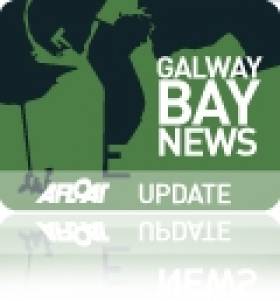Displaying items by tag: Watchtower
President Opens Refurbished Galway Fishery Watchtower
#GalwayHarbour - President Michael D Higgins performed the official opening of the Fishery Watchtower Museum at Wolfe Tone Bridge in Galway city centre last Friday 24 March.
Inland Fisheries Ireland (IFI) worked in partnership with Duchas na Gaillimhe/Galway Civic Trust in revitalising the Victorian-era structure at the mouth of the River Corrib.
As owner of the tower, IFI said it was acutely aware of its responsibility to preserve the protected landmark and to ensure that safe access was provided.
The Watchtower was acquired when the Galway Fishery, popular for salmon angling, was purchased by the State in 1978.
At that time, the tower had a very practical purpose and in addition to monitoring salmon movements was also used to ensure that no untoward activity (poaching) occurred on the adjacent section of the Corrib, as well as acting as a base for a salmon draft net station. Following the purchase by the State netting of salmon ceased.
From 1997, the tower was operated by the trust as a tourist attraction and fisheries museum under a licence agreement with the WRFB, which was subsequently subsumed into IFI, and proved popular with tourists and locals alike up until the tower became inaccessible in 2007 due to deterioration in the access bridge.
With safe access to the tower no longer available, pressure came on for the bridge to be replaced, and the work of Delo Collier of the trust, in never giving up on the project, was instrumental in bringing about the provision of the new bridge and refurbishment works.
Others key to bringing the tower back to life include IFI fishery manager Seamus Hartigan and Caroline McNeill, involved in the management of the interior refurbishment.
IFI also acknowledged the support of Galway City Council throughout – in particular that provided by Kevin Swift, who worked with IFI and the trust when funding was being sought through Fáilte Ireland over a number of years to replace the bridge.
When Fáilte Ireland eventually advised in early 2012 that it could not support the project, IFI decided to proceed and fund the new bridge with some support from Galway City Council.
The old collapsed bridge, which had stood for 160 years since the tower’s construction in the mid-1800s, was removed by IFI personnel in June 2012 – not an easy undertaking given its location and dangerous condition.
The new replacement bridge was designed by local architects Simon J Kelly & Co and blends in seamlessly with the pedestrian walkway on the upstream side of Wolfe Tone Bridge, which it abuts. The new bridge was installed by Ward & Burke Construction Ltd in March 2013 and engineering and advisory services were provided by ARUP.
Following the installation of the new bridge, the trust and IFI again had easy access to the tower and work began in partnership to refurbish the building which had deteriorated over the previous number of years.
IFI is sure anyone who has the opportunity to visit the tower will be impressed with the work done, the museum exhibits and of course the unobstructed panoramic views of Galway Bay and the lower Corrib.
Since its 'unofficial' opening in late summer 2014, almost 4,000 have visited the tower, and IFI says the comments in the visitors book have been very complimentary.
The fisheries body is also sure that anyone who has the opportunity to visit – whether tourists or local Galwegians – will be impressed with the work done, the museum exhibits and the unobstructed panoramic views it affords of Galway Bay and the lower Corrib.





























































